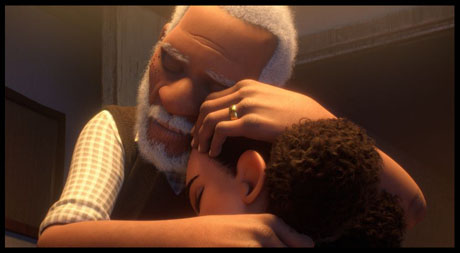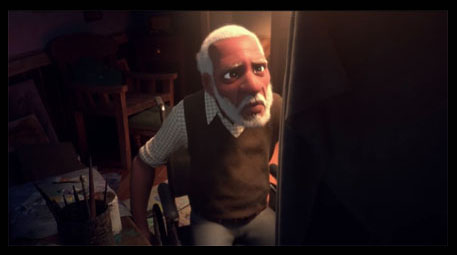
Disney, DreamWorks and Pixar animator Frank E. Abney III (who also executive produced Sony’s Hair Love) has directed a new animated short film. The poetic Canvas debuts this Friday December 11th on Netflix. Abney discusses the making of this passion project, his contributions to Pixar’s Soul and awards buzz.
Jackson Murphy: A lot of people say it takes about five years to make an animated feature, and I read it took you about five years to make this short. Is that true, and where did this journey begin?
Frank Abney: Yeah, it did. I don’t know what it is about this sweet spot of five years for personal shorts, too. There’s a lot of shorts that happen outside of the studio system that happen take around five years. I was in a pretty bad creative funk during this time period. My niece was young. I would watch her run around and do what kids do. She had this light about her – this spark. She was very care-free and would bring joy without even trying. She was just being herself. That was really inspiring to see – and taking that in as an adult and letting the worries of the world and where my place was in the industry kind of melt away. I was inspired to create something.

Frank Abney: That was the ultimate goal of getting into this business was wanting to create for myself. With that inspiration, I wanted to create something personal. One of the things that hit my family hard was losing my dad when I was five. I watched how my mom would navigate when I was growing up. Sometimes when she was on the phone, she would doodle on whatever paper was near her, and I would check it out, and it wasn’t bad. I wonder if there’s an artist background… or something that was never pursued. What else could’ve been left behind after my dad passed?
And also thinking about my grandfather who was around when I was growing up. He was very stoic and quiet, and I was wondering what the story was behind that. Through all these things, Canvas came about, and I was able to put all of that into this story about the grandfather losing his inspiration to create and his granddaughter being the catalyst of him facing this loss and coming out of it with the help of his family.
JM: There are several elements of Canvas that spoke to me. The first is that my uncle has been an art teacher for more than 45 years.
FA: Wow. That’s great.
JM: What speaks to you about painting, and what do you think artwork can mean to someone?
FA: Painting was one of my early things in high school that I enjoyed doing. Between that and drawing, that was kind of my way of getting out how I interpret the world. That’s ultimately what art could do for us – be it painting or whatever medium. It’s allowing us to have an outlet to express how we’re taking in all the stimuli and all the good things and the bad of the world and interpreting that – and putting it through the machine of our brain and outputting our expression.
JM: Art is powerful. And the other thing is that when I went over to my grandparents’ houses when I was young, I would do certain things. I knew when I got there that I would be able to play these certain games or draw or look in the newspaper for certain things. And the granddaughter you have in Canvas immediately comes over [to her grandfather’s house] and immediately wants to sit down and draw.

Frank Abney
FA: That kind of pattern is what you usually do. In this case, her love for drawing… every time she shows up, she brings a new drawing. And it’s something that they shared. In the film, she does try to get him to draw with her, but he’s a little reluctant at the time. There’s the passion there so he can share in that joy with her. I have a similar experience. There are certain family members’ houses where I know… my cousin is really into video games or stairs on the side of the house and we could roll down this little hill. Thinking of that and what was her thing that she could love to do at his house and also something that could speak to his issues that he’s having: not being able to create. But also being a part of his granddaughter’s life and being able to watch her do it so effortlessly and being inspired by that. I wanted him to have that around him to be one of those things that could help nudge him if you really pay attention to it.
JM: Did you know you always wanted to have CGI and some strong 2D elements as well?
FA: Oh yeah. The Lion King was the film that really made me want to jump into animation. That was the first film that I really saw myself in on a personal level because of losing my father when I was little. Watching Simba go through this loss and the fears of the oncoming responsibilities as an adult. I wanted to pay some kind of respect to 2D animation. And also, there’s something really beautiful about hand-drawn animation. It’s a direct line from your soul through your hand. I wanted to incorporate that in some of these sequences that were a little more ethereal.
JM: You are credited not only as the director but also for doing some of the animation itself. So what specifically did you do?
FA: I animated some of the shots in the beginning when the grandfather wakes up. And there’s some key moments towards the end when he’s faced with this canvas and he’s a little reluctant in connecting with it… and when we come back from that. I hadn’t done the 2D animation in a while, but I took one of the shots on there… a reaction shot of the grandmother smiling.
JM: And this was a Kickstarter campaign in early 2019. Nerve-racking, right, to keep refreshing that page and look at the total?

FA: Oh yeah. Just hitting the button to submit was nerve-racking. For one, it’s a huge commitment because I know that that was going to be a huge job in itself in keeping people interested but also not feeling like I’m spamming them with the short film over and over again until they’re sick of it. It was great seeing the response – seeing how excited people were for the characters when I released them on Twitter and Instagram. Overall the positive response to see something that was personal to me was really special.
JM: And then when did Netflix see what was personal for you and want to jump on board with Canvas?
FA: They saw it pretty early on – a little before the Kickstarter, when I initially posted drawings of the characters. I got a message saying they felt like it was something that they could get behind and support in some way. They asked if I needed anything. I kept in touch over the next year or so checking in and letting them know how it’s going and showing some iterations… really hoping we could make some kind of partnership with this. And it ended-up working out!
JM: Yes it did! I was able to watch it through a shorts presentation Netflix had recently. It’s gotta feel good for it out to be out there and for people to start seeing it.
FA: Yes. You’re kind of stuck in this bubble and this rinse/repeat of working on this thing every night. I’d go to work and come home and wait for my kids to go to sleep and then work on this. There’s this pattern, and then you hit that phase of finishing it… and then it’s done and now you’re nervously waiting. It’s kind of like the experience of working on some of these features at the studios I’ve worked. When you see it in a theater with a general audience, you’re sitting back and looking to your sides and making sure people are reacting where they should react. That nervous, sweat-inducing feeling. But it’s a beautiful experience, too, because you’re putting a piece of yourself up there and hoping to connect and resonate with people on different levels.
JM: And speaking of features, I want to shift for just a second to Pixar’s Soul. What can we look for from you specifically in it?

FA: On the animation side, I spent most of my time animating Joe. There’s some stuff when we first see Joe and at the club – and later on… there’s an exchange when he’s trying to fight for something he really, really wants. Among other ones, too, but those are some of my favorites. And outside of animation, I was involved on the cultural trust to make sure that we’re bringing something authentic to the screen and spoke to our experience as Black Americans experiencing life. We wanted to paint a nice picture that felt truthful.
JM: I’m sure it will be a big hit on Disney+ this Christmas. NBA player Harrison Barnes from the Sacramento Kings is an EP on Canvas. Were you two friends?
FA: I was introduced to him through Matthew A. Cherry, who I worked with on Hair Love. I had a conversation with Harrison. He was interested to see what I was doing with the film and what the goals were and what story I wanted to tell. It was really nice to engage on a more creative level – with someone wanting to support the film in the way he did. It was nice to be able to talk about it creatively and express those goals and see that it was something he really cared about. He invested in it, and we’ve kept in touch and I update him on how things have been going. It’s been really cool.
JM: Look at what Matthew Cherry did with Hair Love. Look at what Kobe Bryant did with Dear Basketball. This track record of athletes winning the Academy Award for Best Animated Short Film. And now you’re in this with Harrison Barnes. Is that gonna be in the back of your mind for the next four or five months?
FA: I mean… maybe now! (laughs) It hasn’t, but all of that stuff is icing on the cake for sure. Being able to share this film with everyone and having such supporters like Harrison and my executive producers… it was really heartwarming to have that level of support and also the team involved. Any accolades that come along with it, it’s just more icing on top.
- INTERVIEW: Strap In For “Mars Express” - April 30, 2024
- INTERVIEW: Jeff Fowler On “Knuckles” And “Sonic 3” - April 22, 2024
- INTERVIEW: “Inside Out 2” Director And Producer On Pixar Sequel - April 16, 2024


 December 7th, 2020
December 7th, 2020  Jackson Murphy
Jackson Murphy  Posted in
Posted in  Tags:
Tags: 






